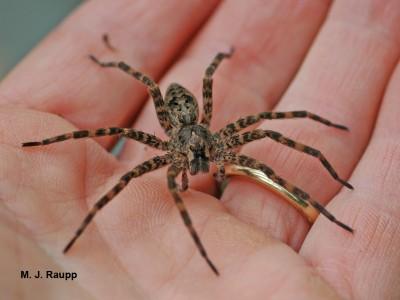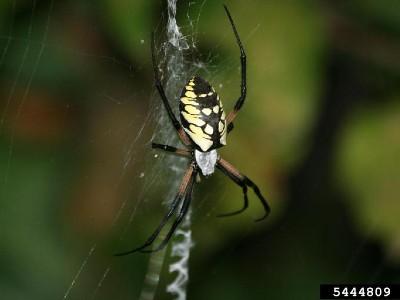Common Predatory Spiders
-

Wood spider carrying an egg sac
Photo: M. Raupp, UMD
-

Wolf spider with spiderlings
Photo: M. Raupp, UMD
-

Fish spider
Fish spider. Photo: M. Raupp, UMD
-

Yellow garden spider
Photo: Richard Floyd, Creative Ideas LLC, Bugwood.org
-
Spiders are not insects, although they are closely related, but they are true friends to the gardener. Spiders are arachnids and have two main body parts (instead of three) and eight legs (instead of six) – what they lack in body parts, they make up for in legs!
-
In spite of the reaction they typically elicit from the average human, all spiders are predators and aid us by eating many garden pests.
-
Hunting spiders have prominent eyes and good eyesight to see their prey, and instead of large webs they construct small silken shelters in which to rest. They actively hunt down their prey. Hunting spiders include wolf and jumping spiders
-
Web spinners create silken webs, but have poor vision and rely on the vibrations of insects captured in their webs to detect their prey. They patiently wait for their prey to become entangled. Web spinners include the orb weavers.
-
Ambush, or sit-and-wait, spiders have patience on their side. They sit motionless on plants or flowers and pounce in ambush on unwary insects that wander near. Ambush spiders include funnel weaver (or grass), crab (or flower) spiders, and daddy longlegs (a distant relative of spiders)
-
No matter what method they use, though, spiders substantially reduce populations of pest insects in the garden.
Life stage(s) that feed on pests: Spiderlings and adults.
Insect(s) fed on: Most spiders are generalists and will eat almost any appropriately sized insect, as well as other spiders and related arthropods.
Spider eggs: Are typically enclosed within a silken sac that may be hung in a web or hidden from sight.
Spiderlings: Resemble adults but are smaller, and frequently have variations in coloring and markings.
Adults:
-
There are many species of orb weaver spiders, ranging in size from small to fairly large, typically black or brown marked with cream or yellow, and minimally hairy. The familiar black and yellow orb spiders (argiope) are frequently found in late summer in their large, beautifully patterned concentric webs that often have a zigzag stripe of webbing down the center.
-
Wolf spiders may get quite large, are hairy with long hairy legs, and are dark in color, but may have contrasting lighter markings that help camouflage them. The female is unusual in that she carries her egg sack beneath her and her newly hatched spiderlings on her back. (See photo above.)
-
Jumping spiders are very active small to medium sized spiders that may jump several times their body length when attacking prey. They are hairy and often have bright colorful markings on a dark, iridescent metallic-colored abdomen. Jumping spiders have a very prominent pair of eyes in the middle of the first of 3 rows of eyes.
-
Funnel weavers, or grass spiders, are medium sized, hairy spiders, typically brown in color and may have lighter markings on the back. They create unique flat webs stretched across the ground or between grasses or plants, with a central entry hole which leads into a narrow funnel-shaped web.
-
Crab spiders have bulbous abdomens, are minimally-hairy, and are brightly colored like the flowers and leaves they sit on. The front two pairs of legs are particularly elongated and held out sideways, crablike.
-
Daddy longlegs, also called harvestmen, have very long thin legs, globular non-hairy bodies without a distinct head, are brown or grayish, and lack poison (unlike its spider cousins). Daddy longlegs are active hunters of a wide variety of soft-bodied insects, slugs, and mites, and will also scavenge dead insects.
Where to find: Spiders are common throughout the garden and landscape, and may be found on the ground, or in herbaceous plants, grasses, trees and shrubs.
-
Some web spinners are found in webs constructed barely above the ground, while others are fairly high up in trees or shrubs.
-
Wolf spiders are active day and night, and may be found on the ground, in or under litter, on low vegetation, or in burrows. Jumping spiders are active during the day seeking prey both on plants and on the ground.
-
Crab spiders are found waiting patiently on the plant flowers and leaves that attract their preferred prey. The flat webs of funnel weavers are often seen stretched over grasses or low bushes sparkling with dew in the early morning, and the spiders may be found lurking at the narrow end of their funnel shaped webs.
How to attract and conserve spiders: Do not use broad-spectrum insecticides. Provide grassy perennials for over-wintering sites. Bundles of straw placed near or between garden rows will provide shelter and cover for hunting spiders.
Contributors: Mike Raupp, Jon Traunfeld, and Chris Sargent